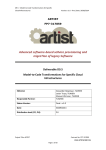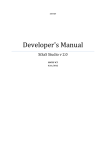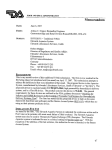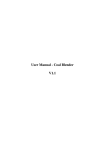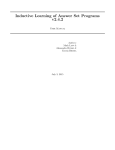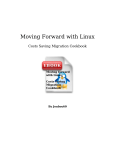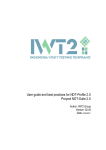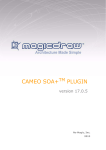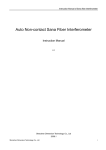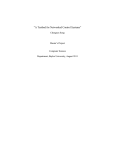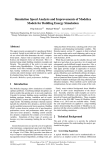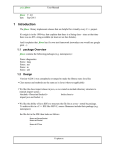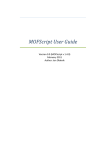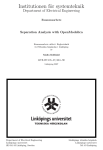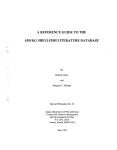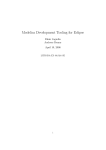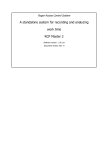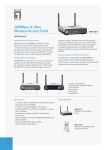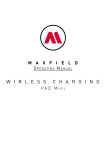Download User`s Manual - ModelBased.net
Transcript
SINTEF User'sManual SiSaSStudiov2.0 SINTEFICT 6/12/2012 USER'SMANUAL F OR S I S A S S TUDIOV 2.0 Version:0.1 Contributors: FranckChauvel–SINTEF/ICT Summary: This document briefly list the features integrated in the SiSaS Studio (version 2.0) and explainshowtousethem.Italsooverviewthedevelopmentprocessunderlyingtheuseofthe SiSaSStudio. ChangeHistory: Version 0.2 0.1 Date ChangesDescription June13,2012 June12,2012 Mainsectionfilledout InitialOutline Author F.Chauvel F.Chauvel ©2009–2012SINTEF 1 TABLEOFCONTENTS 1 Introduction................................................................................................................................................................3 2 InstallingtheSiSaSStudio....................................................................................................................................3 3 4 5 6 2.1 InstallationFromaBundle.........................................................................................................................3 2.2 InstallationFromtheEclipseUpdateSite............................................................................................3 DevelopingWithSiSaSStudio.............................................................................................................................4 3.1 ModellingwithEnterpriseArchitect......................................................................................................5 3.2 ModellingwithPapyrusUML....................................................................................................................5 CodeGenerationwiththeSiSaSStudio...........................................................................................................6 4.1 Buildinga"PlainOld"JavaApplication.................................................................................................7 4.2 BuildingaJEE3Application.......................................................................................................................9 4.3 BuildingWebServices..................................................................................................................................9 4.4 BuildingRESTServices.................................................................................................................................9 4.5 BuildingOGC/WPSApplications..............................................................................................................9 Tutorials.......................................................................................................................................................................9 5.1 CreatingCustomProjectTemplates........................................................................................................9 5.2 DevelopingNewTransformations........................................................................................................10 References................................................................................................................................................................10 ©2009–2012SINTEF 2 1 INTRODUCTION This document is about the SiSaS Studio, developed by SINTEF within the SiSaS Project. SiSaS provides tools and methods helping SINTEF researchers to develop and release software, especiallyscientificsoftware.Inthissetting,theSiSaSStudio–asadevelopmentenvironment– providesuserswiththeabilitytomodelsoftwaresystemsandtogeneratepartorthetotalityof theimplementation. ThisdocumentillustrateshowtousetheSiSaSStudiotogeneratevarioussortofcode(Java, XML, etc.) from UML models (mainly). This document mainly focuses on the code generation abilitiesoftheSiSaSStudio,althoughtheSiSaSStudiopermitstobuildUMLmodelsaswell.As all modelling features result from the integration of existing software (EMF plugins, Papyrus editor,etc.),theinterestedreadershallrefertotheassociateddocumentationanduserguides. ItisworthtonotethatthisdocumentdoesnotcovertheinternalarchitectureoftheSiSaS Studio.ItneitherexplainshowtoextendtheSiSaSStudiosoastogenerateanynewtypeof code that could be needed. Interested readers should refer to the companion "Developer's manual". Thisdocumentisorganizedasfollows.Section2explainshowtofetchandinstalltheSiSaS Studio,andlistthirdpartysoftwarethatarerequiredtoproperlyrunandusetheSiSaSStudio. Section 3recallsthe methodologythatcomesalongwiththe SiSaSStudio.Section4divesinto code generation from UML models, including Java application, Web services, JEE systems, etc. Finally, Section 5 provides tutorial explanation on specific issues, especially regarding customizationoftheSiSaSStudio. 2 INSTALLINGTHESISASSTUDIO 2.1 INSTALLATIONFROMABUNDLE The SiSaS Studio bundle can be downloaded as a zip file from the e‐room location: https://project.sintef.no/eRoomReq/Files/ikt/SiSaS/0_44b57/SiSaS_Studio_0.3.zip 1. 2. 3. 4. Unzipthebundletoyourpreferreddirectory Locatetheeclipse.exefileandstartEclipse WhenstartingEclipse,chooseyourworkingdirectory Ifdesired,youcanimporttheprojectsfromtheexamplesdirectory 2.2 INSTALLATIONFROMTHEECLIPSEUPDATESITE Eclipsealsoincludesamechanismtoautomaticallyfetchandinstalladditionalpluginsfromthe Internet. This alternate installation solution requires installing the SiSaS Studio using the followingupdatesite:http://www.modelbased/sisas/etc/sisas‐studio.site Inthissetting,youmusthaveanEclipsedistributionmatchingthefollowingcriteria. Eclipse3.5 EclipseModellingFramework MoFScriptPlugin1.4 PapyrusUMLEditor,v1.12 ©2009–2012SINTEF 3 3 DEVELOPINGWITHSISASSTUDIO The SiSaS Studio has been designed as a support for Model Driven Engineering (MDE). As a general paradigm, MDE advocates a special focus on models describing various aspects of a system,andfromwhichpartorthetotalityofthecodecanbeautomaticallygenerated.Tothis ends, the SiSaS Studio embeds a basic modelling environment and a set of predefined models transformationstogeneratecode.Themodellingenvironment,namedPapyrusallowsusersto graphically create UML models (it supports various types of diagram). The set of predefined modeltransformationallowsuserstoobtaintheimplementationofthemodel,automatically. Convert to EMF/UML model Select the appropriate Project Template Check the completness of the model Generate the Code Model the System using UML and Profiles Figure3.1TheprocessofdevelopingsoftwaresystemswithSiSaSStudio Figure 3.1 above details the process of building an application with the SiSaS Studio. Further examplesareprovidedinSection4,whichillustratethevarioustypesofapplicationsthatcanbe builtwiththeStudio.Thisfivestepsprocessisstructuredasfollows: 1. Modelthe System using UMLandProfiles. In this initial stage, the designer of the system is in charge of describing the system he needs, and annotating the model with specificprofiles(migration,persistence,etc.) 2. ConverttoEMF/UMLmodel.ThetransformationsthatarebundledintheSiSaSStudio exploit UML model stored in a specific format, namely EMF/UML model. It is hence necessary to convert models stored in other format, so as to enable model transformation. 3. Select the appropriate project template. The SiSaS Studio provides a set of predefined templates, representing different code‐level project structure reflecting specificapplicativeordevelopmentframework.Eachtemplatespecifiesasetofartefacts tobeautomaticallygenerated.Theuserhasmerelytoselectthetemplatehewants,orto definedanewoneifnonemeetshisrequirements(cf.Section5.1forfurtherdetailabout templatecreation). 4. Completeness Check. When instantiating a given project template on a specific UML model,theSiSaSStudiowillfirstcheckwhetherthegivenUMLmatchtherequirements oftheselectsetoftransformation.Itisworthtonotethatmodeltransformationsoperate on specific subsets of the UML notation and incomplete or inconsistent model would ©2009–2012SINTEF 4 leadstoill‐formedcode.Toavoidsuchasituation,theSiSaSStudioembedscheckersthat ensure that a given models matches the requirements of the selected model transformations.Suchchecksareautomaticallyperformed. 5. CodeGeneration.AssumingthatthegivenUMLmodeliscompleteandconsistent,the SiSaSStudiowillgeneratealltheartefactsspecifiedintheprojecttemplates.Thisstepis alsoperformedautomatically. 3.1 MODELLINGWITHENTERPRISEARCHITECT Figure 3.2 below shows the look and feel of Enterprise Architect. Enterprise Architect is a commercial CASE tool, which supports the user in designing various UML models, but also supportsothernotationssuchasEAmodels,workflows,etc.EnterpriseArchitect,atleastinits version 8.0, provides a relatively mature graphical interface that let the user build the UML diagramsupportedbytheSiSaStransformations.Unfortunately,theformatusedbyEnterprise Architect to store UML models in not natively supported by the transformation engine embedded in the SiSaS Studio. The resulting models hence have to be converted using the "ConverttoEMF/UML"featureoftheSiSaSStudiopopupmenu(asshownonFigure4.1below). The resulting models can be instantiated using any kind of project templates, but can also be visualizedinthePapyruseditor. Figure3.2ModellinginEnterpriseArchitect 3.2 MODELLINGWITHPAPYRUSUML AnalternativemodellingenvironmentisembeddedintheSiSaSStudio:thePapyrusUMLeditor. This editor has two advantages: it is integrated within the Eclipse framework upon which the SiSasStudioisbuilt,anditstoredUMLmodelsinaformatthatisnativelysupportedbyinternal transformationengine.However,thegraphicalinterfaceofthePapyrusUMLeditorisprobably– ofcoursethisisasubjectivematter–lessmaturethantheoneprovidedbyEnterpriseArchitect. Unlessthemodelunderconstructionincludesveryadvancedfeaturesthatwouldbesupported bythe"ConverttoEMF/UML"feature,wewouldadvisetousetheEnterpriseArchitectmodeller. ©2009–2012SINTEF 5 Figure3.3ModellinginPayprus 4 CODEGENERATIONWITHTHESISASSTUDIO GivenaUMLmodel,theSiSaSStudiopermitstogenerateseveraltypesofapplication.Eachtype of application is described by a "project template" capturing the organization of the resulting code(intermsofdirectorystructuresandgeneratedartefacts).Projecttemplatesmaycontain severalgeneratedartefacts(Javasourcecode,XMLconfigurationfiles,JSPtemplates,etc.)which willallbegeneratedwheninstantiatingagiventemplateonagivenUMLmodel. Internally,theSiSaSStudioencompassesmanymodelstransformations,which,givenaUML model, produces a specific types of code. When instantiating a specific project template, the SiSaS Studio will browse the selected templates, looking for all artefacts that must generated, andtriggerthepropertransformations. The instantiation of project templates can be trigger from the SiSaS Studio popup menu, as shown on Figure 4.1 below. For the record, the SiSaS popup menu appears, when users right‐ clickonanytypeoffilesupportedbytheSiSaSStudio(PapyrusUMLmodelswhosenameends with".uml"inthecurrentversion).Eachmenuentrythatstartswith"Build"reflectsoneproject templatethatcanbeinstantiated.InFigure4.1forinstance,thereisonlyoneprojecttemplate availablewhichpermittogeneratePlainOldJavaObjects(POJO). Figure4.1TheSiSaSStudiopopupmenuandtheinstantiationofprojecttemplates ©2009–2012SINTEF 6 This section reviews the five main templates that are provided with the SiSaS Studio, and describes,foreachofthem,theorganizationthecodethatwillbegenerated. 4.1 BUILDINGA"PLAINOLD"JAVAAPPLICATION Theexpression"PlainOldJavaObjects(POJO)applications"standsforstandardJavaapplications that do not require any specific framework or middleware to run. In that sense, Spring applications,JEEapplications,OSGibundles,etc.arenotPOJOapplications. TheSiSaSStudioincludesaspecificprojecttemplatethatcanusedtogeneratesuchapplications fromUMLmodels.ThisprojecttemplateisillustratedbyFigure4.2below. Figure4.2StructureofPOJOprojecttemplate ThecoderesultingfromthistemplateisactuallyaMaven[13]project.AsanyMavenproject,the resulting project includes a directory named "src" containing the Java sources and a project descriptor named "pom.xml". All Java sources files will be place in the "src/main/java" and properlyorganizedfollowingthepackagestructuredescribedintheUMLmodel. class Class Model User «singleton» Bank +users - email: String password: String + login(String, String) : void 0..* +accounts 0..* Account Customer +owner 1 +initiator 1 +accounts 1..* id: String initialBalance: Double type: AccountType + + + balance() : Double deposit(Double) : void withdraw(Double) : void +source +withdrawals +transactions 0..* - 1 +target «enumeratio... AccountType SAVINGS CHECKING 1 0..* +deposits 0..* Transaction amount: double date: Date +transactions 0..* Figure4.3AsampleBankingapplication,modelledasaUMLdiagraminEnterpriseArchitect In this example we generate code from a UML model describing a simple banking application, which contains 6 classes: Account, AccountType, Bank, Customer, Transaction and User. The relationships between these classes are depicted by Figure 4.3 as a UML class diagram. Assuming that we need to generate the corresponding Java code in the "C:\temp\sisas\demo‐ java"directory,weobtainthefollowingstructure: c:\temp\sisas\demo-java>tree /F Folder PATH listing Volume serial number is E215-6ABF C:. ©2009–2012SINTEF 7 │ pom.xml │ └───src └───main └───java └───bank └───core Account.java AccountType.java Bank.java Customer.java Transaction.java User.java Once the code is generated, Maven permits to automatically compiles and package the application,asshowninthefollowingexample.ThereaderinterestedinusingMavenmayrefer to[13]forexhaustivetutorial. c:\temp\sisas\demo-java>mvn package [INFO] Scanning for projects... [INFO] [INFO] -----------------------------------------------------------------------[INFO] Building Bank 1.0-SNAPSHOT [INFO] -----------------------------------------------------------------------[INFO] [INFO] --- maven-resources-plugin:2.4.3:resources (default-resources) @ Bank --[WARNING] Using platform encoding (Cp1252 actually) to copy filtered resources, i.e. build is platform dependent! [INFO] skip non existing resourceDirectory c:\temp\sisas\demo-java\src\main\reso urces [INFO] [INFO] --- maven-compiler-plugin:2.3.2:compile (default-compile) @ Bank --[WARNING] File encoding has not been set, using platform encoding Cp1252, i.e. b uild is platform dependent! [INFO] Compiling 6 source files to c:\temp\sisas\demo-java\target\classes [INFO] [INFO] --- maven-resources-plugin:2.4.3:testResources (default-testResources) @ Bank --[WARNING] Using platform encoding (Cp1252 actually) to copy filtered resources, i.e. build is platform dependent! [INFO] skip non existing resourceDirectory c:\temp\sisas\demo-java\src\test\reso urces [INFO] [INFO] --- maven-compiler-plugin:2.3.2:testCompile (default-testCompile) @ Bank --[INFO] No sources to compile [INFO] [INFO] --- maven-surefire-plugin:2.7.2:test (default-test) @ Bank --[INFO] No tests to run. [INFO] Surefire report directory: c:\temp\sisas\demo-java\target\surefire-report s ------------------------------------------------------T E S T S ------------------------------------------------------There are no tests to run. Results : Tests run: 0, Failures: 0, Errors: 0, Skipped: 0 [INFO] [INFO] [INFO] [INFO] [INFO] [INFO] [INFO] [INFO] [INFO] [INFO] --- maven-jar-plugin:2.3.1:jar (default-jar) @ Bank --Building jar: c:\temp\sisas\demo-java\target\Bank-1.0-SNAPSHOT.jar -----------------------------------------------------------------------BUILD SUCCESS -----------------------------------------------------------------------Total time: 2.018s Finished at: Wed Jun 13 11:58:21 CEST 2012 Final Memory: 10M/243M ------------------------------------------------------------------------ ©2009–2012SINTEF 8 OnceMavenhascompiledandpackagedthesource,weobtainanewdirectorycalled"target", containing all the compiled class, plus a release of our project as a JAR file entitled "Bank‐0.1‐ SNAPSHOT.jar",whichcanbedistributed. c:\temp\sisas\demo-java>tree /F Folder PATH listing Volume serial number is E215-6ABF C:. │ pom.xml │ ├───src │ └───main │ └───java │ └───bank │ └───core │ Account.java │ AccountType.java │ Bank.java │ Customer.java │ Transaction.java │ User.java │ └───target │ Bank-1.0-SNAPSHOT.jar │ ├───classes │ └───bank │ └───core │ Account.class │ AccountType.class │ Bank.class │ Customer.class │ Transaction.class │ User.class │ ├───maven-archiver │ pom.properties │ └───surefire 4.2 BUILDINGAJEE3APPLICATION 4.3 BUILDINGWEBSERVICES 4.4 BUILDINGRESTSERVICES 4.5 BUILDINGOGC/WPSAPPLICATIONS 5 TUTORIALS 5.1 CREATINGCUSTOMPROJECTTEMPLATES TheSiSaSStudioletyoudefineyourownprojecttemplatessoastocustomizethewayyouwant thegeneratedcodetobeorganized.Thedefinitionofanewtemplateisatwo‐stepprocess: Create a new Project Template (File New Others Example EMF Wizards ProjectTemplate) o Theprojecttemplateeditorletyouaddnewelementbyright‐clickingandselecting thetypeofchildelementyouwanttoappend.Figure5.1belowillustratetheuseof theProjectTemplateEditor. ©2009–2012SINTEF 9 Project Templates are made of two types of elements: "Generated Artefacts" and "Directories". Generated Artefacts are artefacts that will be generated when the template will be instantiated. They must have an "Artefact type" indicating which transformation can be applied on them. Directories represent the directory structurecontainingthegeneratedartefacts. TomakethetemplateavailableintheSiSaSStudiopopupmenu,youmustregisterthis newtemplate,byusingthe"RegisterTemplate"entryoftheSiSaSStudiopopupmenu.It isworthtonotethattemplatesareregisteredonlyduringthecurrentsession. o Figure5.1EditingProjecttemplates 5.2 DEVELOPINGNEWTRANSFORMATIONS TheSiSaSStudiocanbeextendedwithnewtransformationsiftheprovidedonedoesnotcover yourneeds.However,suchextensionisconsiderasfurtherdevelopmentoftheStudioitself,and doesnotreallyfallwithinthescopeofthisdocument.Addingnewtransformations,debugging existingones,oraddingnewtemplatesaredetailedinthedevelopermanual. 6 REFERENCES 1. EricClayberg,DanRubel.EclipsePlug‐ins.4thedition,Addison‐Wesley,2009. 2. BruceEckel,ThinkinginJava.4thedition,PrenticeHall,2006. 3. KitoD.Mann.JavaServerFacesinAction.ManningPublications,2005. 4. Jon Oldevik. MOFScriptUserGuide. Unpublished. Version 1.0, February 2011. (available athttp://eclipse.org/gmt/mofscript/) 5. GøranK.Olsen.SiSaSStudio–UserManual.Volume1,2and3.Unpublished. 6. Object Management Group (OMG). Service oriented architecture Modeling Language (SoaML) ‐ Specification for the UML Profile and Metamodel for Services (UPMS) SoaML. ptc/2009‐12‐09.2009.(seehttp://www.omg.org/spec/SoaML/) 7. Object Management Group (OMG). UnifiedModelingLanguage–Superstructure (v2.4.1). formal/2011‐08‐06.2011.(seehttp://www.uml.org/) 8. OpenModelica.(Seehttp://www.openmodelica.org/) 9. DebuPanda,RezaRahmanandDerekLane.EJB3inAction.ManningPublications,2007. 10. PapyrusUML.(Seehttp://www.eclipse.org/modeling/mdt/papyrus/) ©2009–2012SINTEF 10 11. Chris Richardson. POJO in Action: Developing Enterprise Applications with Lightweight Frameworks.ManningPublications,2006 12. Wladimir Schamai. Modelica Modeling Language (ModelicaML): A UML Profile for Modelica.(availableathttp://www.openmodelica.org/index.php/developer/tools/134) 13. Sonatype.Maven:TheDefinitiveGuide.O'ReillyMedia.September2008. 14. EricVanderVlist.XMLSchemas:TheW3C'sObject‐OrientedDescriptionsforXML.O'Reilly Media.June2002. ©2009–2012SINTEF 11












